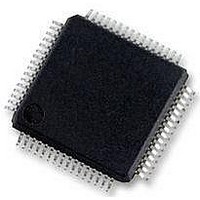MC56F8257MLH Freescale Semiconductor, MC56F8257MLH Datasheet - Page 335

MC56F8257MLH
Manufacturer Part Number
MC56F8257MLH
Description
DSC 64K FLASH 60MHZ 64-LQFP
Manufacturer
Freescale Semiconductor
Series
56F8xxxr
Datasheets
1.TWR-56F8257.pdf
(88 pages)
2.MC56F8245VLD.pdf
(14 pages)
3.MC56F8245VLD.pdf
(2 pages)
4.MC56F8245VLD.pdf
(629 pages)
Specifications of MC56F8257MLH
Core Processor
56800E
Core Size
16-Bit
Speed
60MHz
Connectivity
CAN, I²C, LIN, SCI, SPI
Peripherals
LVD, POR, PWM, WDT
Number Of I /o
54
Program Memory Size
64KB (32K x 16)
Program Memory Type
FLASH
Ram Size
4K x 16
Voltage - Supply (vcc/vdd)
3 V ~ 3.6 V
Data Converters
A/D 16x12b, D/A 1x12b
Oscillator Type
Internal
Operating Temperature
-40°C ~ 105°C
Package / Case
64-LQFP
Product
DSCs
Processor Series
56800E
Core
56800E
Device Million Instructions Per Second
60 MIPs
Maximum Clock Frequency
60 MHz
Number Of Programmable I/os
54
Data Ram Size
8 KB
Operating Supply Voltage
3.3 V
Maximum Operating Temperature
+ 105 C
Mounting Style
SMD/SMT
Minimum Operating Temperature
- 40 C
On-chip Adc
12 bit, 8 Channel
Lead Free Status / RoHS Status
Lead free / RoHS Compliant
Eeprom Size
-
Lead Free Status / Rohs Status
Details
Available stocks
Company
Part Number
Manufacturer
Quantity
Price
Company:
Part Number:
MC56F8257MLH
Manufacturer:
MOTOLOLA
Quantity:
560
Company:
Part Number:
MC56F8257MLH
Manufacturer:
Freescale Semiconductor
Quantity:
10 000
- TWR-56F8257 PDF datasheet
- MC56F8245VLD PDF datasheet #2
- MC56F8245VLD PDF datasheet #3
- MC56F8245VLD PDF datasheet #4
- Current page: 335 of 629
- Download datasheet (4Mb)
10.4.1.1 START Signal
The bus is free when no master device is engaging the bus (both SCL and SDA are high).
When the bus is free, a master may initiate communication by sending a START signal.
A START signal is defined as a high-to-low transition of SDA while SCL is high. This
signal denotes the beginning of a new data transfer (each data transfer might contain
several bytes of data) and brings all slaves out of their idle states.
10.4.1.2 Slave Address Transmission
Immediately after the START signal, the first byte of a data transfer is the slave address
transmitted by the master. This address is a 7-bit calling address followed by an R/W bit.
The R/W bit tells the slave the desired direction of data transfer.
Only the slave with a calling address that matches the one transmitted by the master
responds by sending an acknowledge bit. The slave sends the acknowledge bit by pulling
SDA low at the ninth clock.
No two slaves in the system may have the same address. If the I2C module is the master,
it must not transmit an address that is equal to its own slave address. The I2C module
cannot be master and slave at the same time. However, if arbitration is lost during an
address cycle, the I2C module reverts to slave mode and operates correctly even if it is
being addressed by another master.
10.4.1.3 Data Transfers
When successful slave addressing is achieved, data transfer can proceed on a byte-by-
byte basis in the direction specified by the R/W bit sent by the calling master.
All transfers that follow an address cycle are referred to as data transfers, even if they
carry subaddress information for the slave device.
Each data byte is 8 bits long. Data may be changed only while SCL is low. Data must be
held stable while SCL is high. There is one clock pulse on SCL for each data bit, and the
MSB is transferred first. Each data byte is followed by a ninth (acknowledge) bit, which
is signaled from the receiving device by pulling SDA low at the ninth clock. In summary,
one complete data transfer needs nine clock pulses.
Freescale Semiconductor
• 1 = Read transfer: The slave transmits data to the master
• 0 = Write transfer: The master transmits data to the slave
MC56F825x/4x Reference Manual, Rev. 2, 10/2010
Preliminary
Chapter 10 Inter-Integrated Circuit (I2C)
335
Related parts for MC56F8257MLH
Image
Part Number
Description
Manufacturer
Datasheet
Request
R
Part Number:
Description:
Manufacturer:
Freescale Semiconductor, Inc
Datasheet:
Part Number:
Description:
Manufacturer:
Freescale Semiconductor, Inc
Datasheet:
Part Number:
Description:
Manufacturer:
Freescale Semiconductor, Inc
Datasheet:
Part Number:
Description:
Manufacturer:
Freescale Semiconductor, Inc
Datasheet:
Part Number:
Description:
Manufacturer:
Freescale Semiconductor, Inc
Datasheet:
Part Number:
Description:
Manufacturer:
Freescale Semiconductor, Inc
Datasheet:
Part Number:
Description:
Manufacturer:
Freescale Semiconductor, Inc
Datasheet:
Part Number:
Description:
Manufacturer:
Freescale Semiconductor, Inc
Datasheet:
Part Number:
Description:
Manufacturer:
Freescale Semiconductor, Inc
Datasheet:
Part Number:
Description:
Manufacturer:
Freescale Semiconductor, Inc
Datasheet:
Part Number:
Description:
Manufacturer:
Freescale Semiconductor, Inc
Datasheet:
Part Number:
Description:
Manufacturer:
Freescale Semiconductor, Inc
Datasheet:
Part Number:
Description:
Manufacturer:
Freescale Semiconductor, Inc
Datasheet:
Part Number:
Description:
Manufacturer:
Freescale Semiconductor, Inc
Datasheet:
Part Number:
Description:
Manufacturer:
Freescale Semiconductor, Inc
Datasheet:











